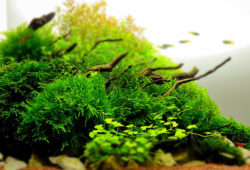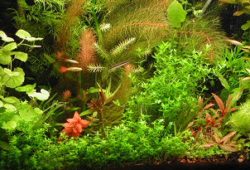PROS & CONS of Aquarium Plants
Of all the different types of aquarium decorations, live plants, coral, and live rock require the biggest investment. They cost more, require more upkeep, and can be hard to find locally. On the other hand, they can also be the most rewarding and beneficial purchases you can make in the fishkeeping hobby, as these decorations serve vital roles in maintaining water chemistry and warding off disease if kept properly.

So here are PROS & CONS for aquarium Plants.
Contents
PROS
Enhanced Appearance
In most cases, a planted freshwater tank will provide you with the most realistic and unique results. Your tank will look more similar to the fish’s natural habitat, and the appearance of the tank will continually change as your plants grow.
Provides a biological filter
Perhaps the most important part of fishkeeping is maintaining water quality to keep your fish happy and disease-free. In fact, some in the hobby half-jokingly call themselves “waterkeepers” instead of fishkeepers or aquarists. Live organic decorations provide biological filters for your aquarium, creating a nutrient cycle that converts harmful chemicals in more manageable ones.
If you are starting a new aquarium, it is imperative for you to become familiar with this cycle (often called the nitrogen cycle) and the cycling process, which you can find here or on many other resources online.
Live Plants are desirable in your tank because they provide filtration in lieu of, or in addition to, your mechanical filter. Plants absorb the harmful chemicals present in every stage of the nitrogen cycle and use it to grow. This means that nitrates, which normally accumulate in a tank and have to be removed via water changes, are less of a problem in a well-planted aquarium.
I have even met a fishkeeper (and fish store owner) in San Francisco who swears that he has not done any water changes in years! Still, I personally do a partial water change (10% to 20%) every two weeks or so in my tanks, as well as top them off occasionally.
Aeration
Many aquariums are aerated with airstones in order to ensure that oxygen levels are high enough for fish to breathe. This can be especially problematic in warmer tanks, as less oxygen is present in the water in higher temperatures, leading many to desperately add additional air stones or filters during a hot day or during ich treatment. A well-planted tank does not have this problem, as plant photosynthesis provides oxygen as a byproduct and is more efficient in keep oxygen levels high than airstones.
Cover
As covered in one of the benefits of decorations in general, most fish are aware of the fact that they are prey in the wild, and are continually stressed if not given places to hide. Aquarium plants are ideal for providing this cover, as they get larger with time, are less likely to have sharp edges, and are more interactive with fish.
Limit Algae Growth
Healthy plants will continuously compete for nutrients against algae, keeping your aquarium glass and ornaments cleaner than in a tank with no aquarium plants.
CONS:
Expensive
Keeping aquarium plants is expensive in comparison to fake or dead organic decorations. In addition to buying the plants, you will also need to buy proper lighting, a method of fertilization, and CO2 (optional).
Lighting is especially costly, as most lights that come in standard aquarium kits are insufficient for keeping aquarium plants alive. As a rule of thumb, your lighting must provide light comparable to daylight (6500Kelvin +) and 2-3 watts per gallon of water in order to keep low light to average light plants.
Requires Preparation
Since you never know whether the plants you bought have been exposed to contaminated/diseased water, ideally they should be quarantined for up to two weeks before being added to your fish tank. Plants can also harbor snails or snail eggs, and you should give them a brush-over if you do not want the creatures in your tank.
In many cases the plants sold at stores are kept within an artificial pot with a sponge substrate. This sponge should be removed carefully off of the roots of the plants before you put them in your substrate, as keeping the pot or sponge can limit the growth of the plant in the long run.
Consistent Maintenance
Many aquarium plants grow rapidly in a good environment and must be trimmed/groomed frequently to keep the appearance you prefer. Plants should also be groomed if they begin to take up too much of the swimming space, or if they cover the top of the tank and keep light from reaching to the shorter plants.
Another aspect of maintenance is identifying dead plants immediately and removing them from the tank, as dead plants can make your tank both extremely dirty and also introduce a higher ammonia output.
May be eaten by fish
Before choosing to buy aquarium plants make sure that none of your fish are prone to eating or destroying plants. As with anything else with fish keeping, research and preparation is key.
Limited Selection
There are a few components to limited selection for aquarium plants
1. Pet stores, even local fish stores, often do not have sizable plant selections and you may find yourself having to look online (and thereby paying shipping!) for the plants that you want.
2. The selection of plants is limited in terms of size/shape/color by nature. If you want an aquarium plant that looks like a fern tree with red flowers, you may be able to find/build a fake one, but you won’t be able to find a real one.
3. Many chain stores incorrectly label regular plants as aquatic plants (such as bamboo) which means that you’ll find your selection even more limited than previously thought. Non-aquatic plants will survive for a few weeks in your tank, but will ultimately die and begin to sully the water and should be avoided.



